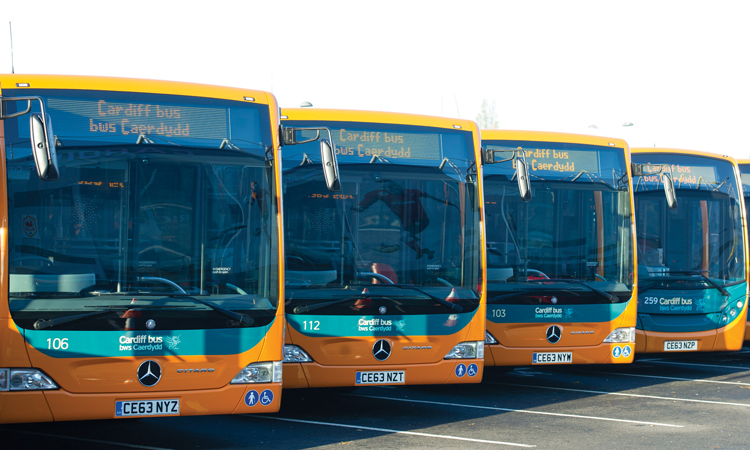The use of real-time information to enhance the customer experience
- Like
- Digg
- Del
- Tumblr
- VKontakte
- Buffer
- Love This
- Odnoklassniki
- Meneame
- Blogger
- Amazon
- Yahoo Mail
- Gmail
- AOL
- Newsvine
- HackerNews
- Evernote
- MySpace
- Mail.ru
- Viadeo
- Line
- Comments
- Yummly
- SMS
- Viber
- Telegram
- Subscribe
- Skype
- Facebook Messenger
- Kakao
- LiveJournal
- Yammer
- Edgar
- Fintel
- Mix
- Instapaper
- Copy Link
Posted: 11 October 2014 | Peter Heath - Cardiff Bus | No comments yet
We live in the information age where the use of technology to enhance the customer’s experience is now taken for granted, particularly by the under 30s, who are a key age group the bus industry must attract and retain for future growth. They are children of an age where technology is an integral part of life; we must therefore focus on providing them with the most immediate information, whilst also ensuring the bus product meets their high expectations. The ability to know exactly when their bus will arrive is now taken for granted and they have little tolerance for a bus that fails to show. We must embrace the use of real-time information in all its aspects to satisfy these requirements. Peter Heath – Operations and Commercial Director of Cardiff Bus – outlines how the operator uses real-time information to enhance the customer experience for bus passengers in Cardiff, the Capital city of Wales.


Cardiff has a population of some 337,000 and is the focal point of the Welsh Valleys. Cardiff Bus operates some 222 buses on an intense urban network serving the city and the eastern part of the adjoining Vale of Glamorgan. The majority of the network is made up of high frequency radial routes with frequencies ranging from 5 to 15 minutes.
Apart from the corridor serving the Cardiff East Park and Ride site, there are few effective bus priority measures and this, combined with high traffic volumes and a compact city centre, leads to a challenging operational environment. Traffic congestion is prevalent leading to delays to buses on many corridors; the real-time information system helps manage this and continue to deliver a bus service that meets customer demand.
The Cardiff Real-Time Passenger Information system is the responsibility of the local authority, Cardiff City Council, and was introduced in 1999 to coincide with Cardiff being one of the host cities for the Rugby World Cup, with matches being played at the new Millennium Stadium which dominates the city centre. The system was supplied by ACIS and they still remain the supplier albeit now under the guise of Vix.
Initially the system was only available for services, buses and bus stops operating to the North of the city but was gradually expanded such that by 2002 it covered the entire city and the Cardiff Bus fleet. The data used in the system covers all bus operators in the city, although many of these do not have the necessary equipment to drive the system installed on their buses. The city benefits from quality bus shelters at most bus stops and many of these have real-time information signs mounted on them. There are now some 458 real-time displays installed in these shelters plus a number of TFT screens found in key locations such as the central rail station, central library, main hospital and the Welsh Government offices.
The real growth in customer expectations for real-time information is now through web-based information and this is available for every bus stop in the city whether it has a physical sign or not. This is a key feature which has been developed in recent years to meet customer demands for real-time information whilst on the move. In particular, the Cardiff Bus App now enables users to obtain real-time information on buses based either on their geographic location or the route they wish to use.
To give bus customers the same freedom as car users, it is essential that they have the ability to check their bus time before they set off for the bus stop, as for many, time waiting at a bus stop is time wasted and a deterrent to use the bus compared to the car.
Through a service provided by Travelline Cymru – the Welsh Government funded organisation which provides travel information for all modes in Wales and beyond – by entering a specific code displayed at the bus stop, customers can also use SMS messaging to obtain real-time information on the next three departures. Use of this system has, however, decreased rapidly in recent years as the use of App-based mobile devices has become the standard.
A key requirement of the system is the ability to send messages to individual bus stops to alert customers to changes to services using that bus stop. This is particularly important because the compact nature of the city centre, and the presence of the 75,000 capacity Millennium Stadium, means that for many city centre events, a number of key city centre bus stops cannot be used. It is therefore vital that the information on the real-time signs can be modified and messages delivered to direct customers to alternative stops.
Being one of the country’s first real-time systems, a PMR radio system is still used for communication as against a GPRS system which is found in more modern systems. This in itself is a restriction on the system, as the volume of data now held by each bus stop sign is so large that it must be physically updated at each change. In a time of local authority financial restraint, the cost of this method of reconfiguration is becoming a burden on the city council so alternative methods of communication potentially using city-wide Wi-Fi are being investigated.
Whilst it is important to deliver accurate and timely information to customers, equally as important is a bus service which is reliable and punctual. The use of the real-time system to manage bus operations in a congested city like Cardiff is therefore vital.
Cardiff Bus controls its operations from a bespoke control room based at its depot near the city centre. Open early to late, seven days per week – we do not have any all-night buses at the moment – the operators are in radio contact with all buses and have access to the entire city CCTV network – approximately 250 cameras. Their most important asset however is the Vix Horizon software suite.
Horizon allows the operators to spot those buses which are not running to schedule – those buses which are running late – and sometimes those which are running early – and take corrective action. Using a graphical display which shows the actual location of each bus on the route compared to its scheduled location, the operator can if necessary adjust the schedule of the delayed bus. If the delay is such that part of a journey must be cancelled, the operator is able to do this knowing if the resulting gap in the service would leave an acceptable level of service for waiting customers.
If corrective action is necessary, it is important customers are kept informed. The Cardiff real-time system works on the basis of, firstly, real-time predictions, but if these are not available, then scheduled times. This is fine, but if a bus is not operating, the scheduled time will display until the departure time from the bus stop, at which time it will simply disappear causing confusion and uncertainly for customers who may want this journey. Such confusion does nothing to inspire confidence in using the bus service.
We resolve this problem by using the ability in Horizon to cancel journeys. Once a journey cancellation is entered, then for each bus stop that journey is scheduled to use on both physical and web-based signs, there will be an indication that the particular departure journey has been cancelled. This gives the customer the ability to amend their travel plans – either waiting for the next bus to their destination or amending their itinerary for the day.
Should it be necessary to identify the exact location of a specific bus, this can also be achieved through Horizon.
Finally, when something does go wrong, the real-time information system allows us to deal effectively with customer feedback. A customer may comment that a bus has been late or early. Reference to the historical real-time data for that day and that stop will show if the customer’s comment was correct and a review over a period of time will show if this is a repeated problem which needs correction to ensure the punctuality of the service improves. Real-time therefore gives a wealth of data for improvements to bus services which previously would have involved expensive and time consuming manual surveys.
A key to improving the punctuality and reliability of bus services is the use of bus priority measures. The wealth of data provided by a real-time information system allows hot spots for delays to be both highlighted to the local authority together with a quantitative measure of their effect on bus services. If improvements are introduced, then reference to before and after data can validate their introduction.
One of the inherent problems with the current Cardiff system is that it requires two separate pieces of equipment on each bus – the on-bus unit, and the radio. Should one of these fail, the bus is not recognised by the system so will not provide any bus stop predictions for the customer and cannot be tracked by our control room operators. Over the next 12 months we will be investing in a new ticketing system on the bus which will have the ability to interface with the real-time system built into it. Before it can enter service each day, a bus must have a functioning ticket machine so we will therefore always have functioning real-time ability.
We believe that the use of real-time information in Cardiff has enhanced the service we provide our customers – both directly through more accurate information and indirectly by allowing us to better manage bus service provision.
The bus industry has for many years struggled to convey information to customers. For many people, the traditional bus stop timetable is hard to understand – it is much easier to comprehend an image – be it a physical electronic sign at the bus stop or on the screen of a mobile device – which clearly tells you the time of the next bus. Supervision of services in years gone by was through the Roadside Inspector with their pencil and clipboard in hand who knew if the bus that passed him was late, but not what was happening around the rest of the network. Real-time has changed this and one person can now get an overview of the whole network; a modern approach for an industry which can still be steeped in tradition.
Biography


Issue
Issue 5 2014
Related modes
Bus & Coach
Related organisations
Cardiff Bus
Related people
Peter Heath








